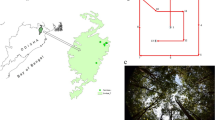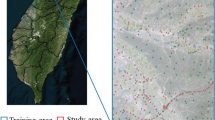Summary
High resolution radiances from SPOT satellite imagery converted to Normalized Difference Vegetation Indices (NDVI) over a 16×16 km2 mixed ground cover study-area in the Apalachicola National Forest in northwest Florida, along with in situ measurements from a Bowen ratio surface flux monitoring system and physical modeling techniques, are used to determine the length manifold beyond which degraded resolution satellite imagery fails to capture flux variability over the scene. The investigation is relevant to an understanding of how bias error is generated in methods designed to produce scale-invariant surface flux estimates from satellite measurements. Error estimates are based on assigning characteristic NDVI values to the four predominant types of ground cover found within the study-area. An open site near the center of the study-area, which satisfies the conditions for surface flux monitoring, is used for obtaining input data for a biosphere-atmosphere exchange model designed to calculate representative fluxes for the different ground covers. Continuous 6-minute meteorological and surface flux measurements were made at the monitoring site for a period of 22 days. These measurements are used in conjunction with surface layer theory to provide surface layer profile estimates of wind speed, temperature, and relative humidity at the tops of the forested sites. The measured and derived meteorological parameters, together with representative biophysical parameters, are used as input to the biosphere-atmosphere exchange model. By representing sensible and latent heat flux distributions due to the variable ground cover with characteristic NDVI values at 20-m resolution, baseline area-wide sensible and latent heat flux quantities are calculated. Error-growth curves as a function of spatial resolution for the fluxes are found by degrading the resolution of the SPOT radiances used to calculate NDVI, and rationing the associated area-wide fluxes to the baseline values. The point at which an error-growth curve becomes invariant represents the edge of a length manifold beyond which the satellite input no longer contains information on surface flux variability, even though NDVI variability continues at all scales up to that of the complete SPOT scene. The error-growth curves are non-linear, with all the error build-up taking place between 20 m and 1.6 km. Decreasing the spatial resolution of the NDVI information down to or below 1.6 km, introduces bias errors in the area-wide surface flux estimates of 10% for sensible heat and 8% for latent heat. The underlying assumptions and modeling produce uncertainty in estimating the manifold limits, however, the principal objective is to show that in using satellite data for scale-invariant surface flux retrieval, there is an optimal spatial resolution factor that can be objectively quantified.
Similar content being viewed by others
References
Avissar, R, Pielke, R. A., 1989: A parameterization of heterogeneous land surfaces for atmospheric numerical models and its impact on regional meterology.Mon. Wea. Rev.,117, 2113–2136.
Blyth, E. M., Dolman, A. J., Noilhan, J., 1994: The effect of forest on mesoscale rainfall: An example from HAPEX-MOBILHY.J. Appl. Meteor.,33, 445–454.
Crosson, W. L., Smith, E. A., 1992: Estimation of surface heat and moisture fluxes over a prairie grassland. Part 2. Two-dimensional time filtering and site variablity.J. Geophys. Res.,97, 18583–18598.
Crosson, W. L., Smith, E. A., Cooper, H. J., 1993: Estimation of surface heat and moisture fluxes over a prairie grassland. Part 4. Impact of satellite remote sensing of slow canopy variables on performances of a hybrid biosphere model.J. Geophys. Res.,98, 4979–4999.
Dickinson, R. E., 1984: Modeling evapotranspiration for three-dimensional global climate models. In: Hansen, J. E., Takahashi, T. (eds.),Climate Processes and Climate Sensitivity, Geophys. Monogr. Ser., Vol. 29, Washington DC: AGU, 58–72.
Dickinson, R. E., Henderson-Sellers, A., Kennedy, P. J., Wilson, M. F., 1986: Biosphere-atmosphere transfer scheme (BATS) for the NCAR community climate model. NCAR Technical Note/TN-275+STR, National Center for Atmospheric Research, Boulder, CO, 69 pp.
Dickinson, R. E., Henderson-Sellers, A., Kennedy, P. J., 1993: Biosphere-atmosphere transfer scheme (BATS) version le as coupled to the NCAR community climate model. NCAR Technical Note, National Center for Atmospheric Research/Climate and Global Dynamics Research Divsion, Boulder, CO, 72 pp.
Dooge, J. C. I., 1992: Hydrologic models and climate change.J. Geophys. Res.,97, 2677–2686.
Li, B., Avissar, R., 1994: The impact of spatial variability of land-surface characteristics on land-surface heat fluxes.J. Climatol.,7, 525–537.
Henderson-Sellers, A., Pitman, A. J., 1992: Land-surface schemes for future climate models: Specification, aggregation and heterogeneity.J. Geophys. Res.,97, 2687–2696.
Mahfouf, J.-F., Richard, E., Mascart, P., 1987. The influence of soil and vegetation on the developement of mesoscale circulation.J. Climatol. Appl. Meteor.,26, 1483–1495.
McCaughey, J. H., 1985. A radiation and energy balance study of mature forest and clear cut sites.Bound.-Layer Meteor.,32, 1–24.
Monteith, J. L., 1975:Vegetation and the Atmosphere, vol. 1, New York: Academic Press, 278 pp.
Nie, D., Demetriades-Shah, T., Kanemasu, E. T., 1992: Surface energy fluxes on four slopes during FIFE 1988.J. Geophys. Res.,97, 18641–18649.
Pielke, R. A., 1984:Mesoscale Meteorological Modeling. New York: Academic Press, 612 pp.
Sellers, P. J., Hall, F. G., Asrar, G., Strebel, D. E., Murphy, R. E., 1992a: An overview of the First International Satellite Land Surface Climatology Project (ISLSCP) Field Experiment (FIFE).J. Geophys. Res.,97, 18345–18371.
Sellers, P. J., Heiser, M. D., Hall, F. G., 1992b: Relations between surface conductance and spectral vegetation indices at intermediate (100 m2 to 15 km2) length scales.J. Geophys. Res.,97, 19033–19059.
Smith, E. A., Hsu, A. Y., Crosson, W. L., Field, R. T., Fritschen, L. J., Gurney, R. J., Kanemasu, E. T., Kustas, W. P., Nie, D., Shuttleworth, W. J., Stewart, J. B., Verma, S. B., Weaver, H. L., Wesely, M. L., 1992a: Area averaged surface fluxes and their time-space variability over the FIFE experimental domain.J. Geophys. Res.,97, 18599–18622.
Smith, E. A., Crosson, W. L., Tanner, B. D., 1992b. Estimation of surface heat and moisture fluxes over a prairie grassland. Part 1. In situ energy budget measurements incorporating a cooled mirror dew point hygrometer.J. Geophys. Res.,97, 18557–18582.
Smith, E. A., Crosson, W. L., Cooper, H. J., Heng-yi, W., 1993: Estimation of surface heat and moisture fluxes over a prairie grassland. Part 3. Design of a hybrid physical/remote sensing biosphere model.J. Geophys. Res.,98, 4951–4978.
Smith, E. A., Wai, M. M.-K., Cooper, H. J., Rubes, M. T., Hsu, A., 1994. Linking boundary circulations and surface processes during FIFE 89. Part 1: Observational analysis.J. Atmos. Sci.,51, 1497–1529.
Stull, R. B., 1988:An Introduction to Boundary Layer Meteorology. London: Kluwer Academic Publishers, 666 pp.
Author information
Authors and Affiliations
Additional information
With 10 Figures
Rights and permissions
About this article
Cite this article
Smith, E.A., Cooper, H.J. Pilot study using SPOT satellite imagery over Apalachicola national forest to determine appropriate spatial scale for area-wide aggregation of surface fluxes. Meteorl. Atmos. Phys. 58, 179–192 (1996). https://doi.org/10.1007/BF01027564
Received:
Revised:
Published:
Issue Date:
DOI: https://doi.org/10.1007/BF01027564




